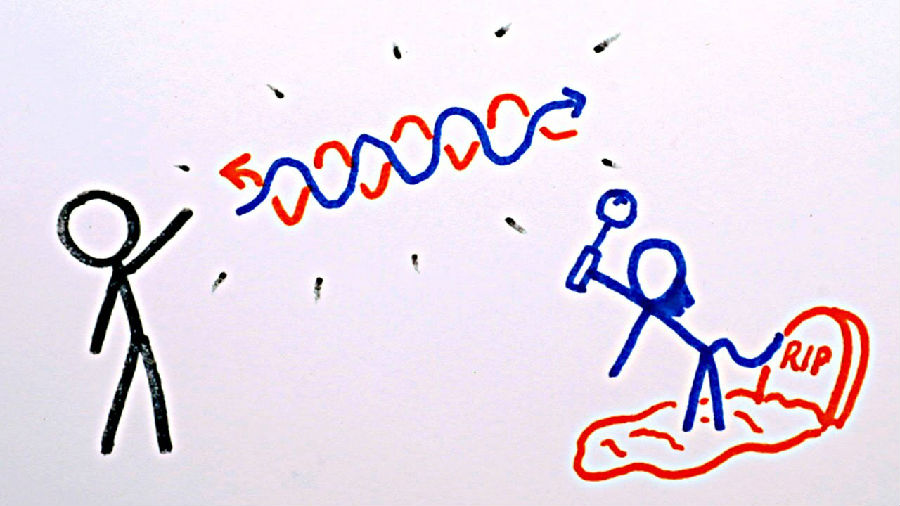In order for us to see something, it either needs to emit light directly (like the sun or a lightbulb filament or firefly)
为了让我们的眼睛能够看到东西,它必须要么自己发光(比如太阳,灯泡,火焰,或者萤火虫),
or else have photons of light bounce off of it and into our eyes.
或者有光子从上面反射到我们的眼睛里
But how do we see light itself?
但是我们怎么看到光呢?
You can't bounce light off of light
你不能让光本身从光上面反射,
(just like you can't bounce slinky waves or ripples in the water off of each other - they just pass right through!),
就好像我们不能让水波从水波身上反射一样——它们只会直接穿过对方。
plus, if you "look" at a photon of light in the normal everyday way, that means your eye or camera or photodetector will absorb it
另外,如果你看到了一个光子,那么说明这个光子已经进入了我们的眼睛或者照相机,摄像机就会把它吸收了。
- and then it's gone. Destroyed! Annihilated!
光子就消失了,不复存在了,湮灭了。
It's like if you want to test how much weight a bridge can support before it falls down…
就好像你想试试看一座桥最多能承重多少…
once you've done your measurement, you have the information you wanted but you no longer have a bridge.
当你测量完成的时候,桥也就倒了。你也就不再有这座桥了。
So in order to "see" light, we need to use non-destructive testing.
为了看见光,我们必须使用非破坏性的测量方式。
One way of doing that is to make a super dark, super cold box
有一个办法是构造一个非常黑,非常冷的盒子

and cover the inside with a really really shiny mirror - a mirror so excellently reflective that photons of light bounce back and forth more than a BILLION times before being absorbed.
然后把里面垫上特别光滑的镜子,光滑到能够让光子在里面反复反射,在里面反射十亿次以上也不会被吸收。
In that time, they'll travel a distance equivalent to one trip around earth.
让它在里面移动的距离超过绕地球一圈。
This box is also so cold and dark that only occasionally will there even be one photon inside.
这个盒子是如此的黑,如此的冷,甚至有时候运气好的话,里面可能只有一个光子。
And if there is one, how do we tell without destroying it?
但即便真的有了,我们怎么在不破坏它的情况下确认呢?
Well, we send an atom through the box, an atom in a superposition of two different atomic states, just like Schrodinger's cat!
这样吧,我们让一个原子穿过这个盒子,穿过之前这个原子处于两种原子状态的叠加态,就好像薛定谔的猫一样。
If there's no photon inside the mirror box, then when the atom comes out the other side, we'll most likely measure it as being in a certain one of the states - let's call it "dead".
而如果盒子里没有光子,那么穿过盒子后的原子,很有可能就处于一个确定的状态,我们可以把这种状态称为“死”。
But if there is a photon in there, and we carefully send the atom through so it doesn't actually destroy the photon, the atom-photon interactions changes the odds -
而如果盒子里有光子,我们把原子送过盒子,但又不破坏这个光子,光子的原子的相互作用会把几率改变
so now it's an overwhelming chance that we see that atom as "alive."
这时,原子处于“活”的概率可能会大大增加。
After sending through a few atoms, if they're mainly in the "alive" state, then we know there's a photon in the box!
如果我们送过去好几个原子,他们出来之后都处在“活”的状态,那么我们可以说盒子里有光子!
And if they're "dead": no photon.
而如果它们都还是“死”的状态,我们说,这里没有光子。
It's kind of like sending a pinwheel through a dark chamber, and if it comes out the other side spinning, you know the wind is blowing.
这就好像把一个风车送过一个暗室,如果出来的风车是转的,我们知道房间里面有风,
If not? No wind.
而如果不转,那么就没有风了。
In fact, once we know there's a photon in there, we can use this cat measurement technique to measure and manipulate other things about the photon:
事实上,一旦我们知道了里面只有一个光子,我们可以用这种薛定谔猫的测量方式来测量光子的其他性质。
we can see how long it bounces back and forth before it gets absorbed, check if it's in a superposition
比如说这个光子会在反射多久后被吸收,它是否处于叠加态,
and even force it into a superposition like Schrodinger's cat itself -
甚至我们可以使它处于叠加态,就如同薛定谔的猫一样
so, not only can we see light, we can now use Schrodinger's cat to measure Schrodinger's cat: Quantum Catception!
现在我们可以用薛定谔的猫来测量薛定谔的猫啦!这就是量子的猫咪解释!











